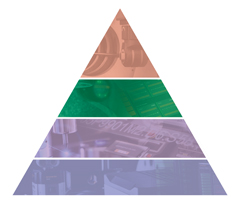Kontrola w trakcie procesu
Aktywna kontrola procesu umożliwia wytwarzanie prawidłowych części obrabianych „za pierwszym razem”.
W warstwie kontroli w toku procesu Piramidy Produktywności Procesu (Productive Process Pyramid™) występują elementy kontroli osadzone w procesie skrawania. Te elementy kontroli aktywnej reagują automatycznie na stan materiału, czynniki zmienności typowe dla procesu oraz na nieplanowane zdarzenia, aby minimalizować niezgodność procesu z wymaganiami.
Zachowuj kontrolę podczas przebiegu skrawania

Warstwa kontroli procesu piramidy produktywności procesu stawia czoła źródłom zmienności, które są typowe dla procesu obróbki, takim jak zużycie narzędzi i zmiany temperatury, dostarczając użytecznej informacji zwrotnej i pozwalając na podejmowanie decyzji w trakcie procesu skrawania.
Jest to kontrola aktywna, stosowana podczas procesu skrawania.
Pomiary w trakcie obróbki umożliwiają
- skrawanie metalu zapewniające reagowanie na takie zmiany w procesie obróbki, jak odkształcenie przedmiotu obrabianego, zużycie narzędzia oraz efekty termiczne,
- aktualizowanie układów współrzędnych, parametrów, offsetów i przebiegu programów logicznych w zależności od stanu materiału.
Funkcja wykrywania uszkodzonych narzędzi rozpoznaje
- obecność narzędzia,
- położenie narzędzia -w celu sprawdzenia, czy nie doszło do wyciągnięcia narzędzia,
- uszkodzoną i/lub ukruszoną krawędź narzędzia.
Kontrola aktywna
Aktywna kontrola procesu umożliwia wytwarzanie prawidłowych części obrabianych „za pierwszym razem”. Nie występuje więc potrzeba rezerwowania mocy przerobowych do operacji poprawek i przeróbek.
Zautomatyzowanie pomiarów w toku produkcji oznacza, że obrabiarki nie będą już oczekiwać na ponowne uruchamianie ich przez operatorów.
Systemy pomiarów w cyklu produkcyjnym wprowadzają do obrabiarek pewien poziom inteligencji, jaka jest im potrzebna do samodzielnego podejmowania decyzji. Umożliwia to bezobsługową obróbkę w długich okresach czasu, zapewniając zwiększenie wydajności produkcji.
Sondy do kontroli przedmiotów obrabianych, system rozpoznawania uszkodzeń narzędzi TRS2 oraz oprogramowanie Productivity+™ firmy Renishaw dostosowują operacje skrawania do bieżącego stanu materiału i środowiska roboczego dzięki automatycznej informacji zwrotnej.
Dokumenty
-
 Broszura: Systemy metrologiczne przeznaczone do kontroli procesu produkcyjnego
Broszura: Systemy metrologiczne przeznaczone do kontroli procesu produkcyjnego
Poprawa produktywności dzięki usprawnieniu kontroli procesów produkcyjnych
